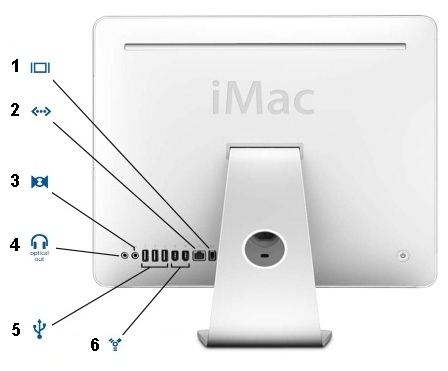iMac (Late 2006): External Ports and Connectors
In this article we'll describe the external ports and connectors on the iMac (Late 2006) model of computers:
iMac (Mid 2006)
iMac (17-inch Late 2006 CD)
iMac (17-inch Late 2006)
iMac (20-inch Late 2006)
iMac (24-inch)
You can find the ports on the bottom right side of the back of the computer, known as the Input/Output (I/O) panel.
Ports and connectors
Mini-DVI video output port
Ethernet Port (10/100/1000 Gigabit Base-T)
Audio in / optical audio in port
Headphone out / optical audio out port
USB 2.0 ports (three ports)
FireWire ports (two ports)

Mini-DVI Video Out Port
Using the Mini-DVI video out port, you can mirror video or extend the size of the Mac OS X desktop (extended desktop mode) with a compatible DVI display or VGA display or projector using the appropriate Apple Mini-DVI adapter:
For DVI displays, use the Apple Mini-DVI to DVI Adapter (M9321G/A).
For VGA displays or projectors use the Apple Mini-DVI to VGA Display Adapter (M9320G/A).
For televisions, projectors or VCRs that use S-video or composite video connectors, use the Apple Mini-DVI to Video Adapter (M9319G/A).
Video mirroring allows you to see the same image that is on the iMac's flat-panel display on an external monitor, television or projector.
Extended desktop mode allows you to connect an external display and use that area in addition to the built-in display for your desktop.
For more information about the video out port, see About the Intel-based iMac Mini-DVI port.
Ethernet Port (10/100/1000 Gigabit Base-T)
The iMac (Late 2006) has a built-in 10/100/1000 Mbit/s Ethernet port. The iMac (Late 2006) computer can be connected to an Ethernet cable from a cable or DSL modem, hub, switch, or router, or to another Macintosh computer. The connected device can be either a 10Base-T or a 100Base-TX device; the port automatically detects which type of device is connected. You don't have to use an Ethernet crossover cable to connect to other Ethernet devices.
Audio In / Optical Audio in port
The Audio In port accommodates both digital optical input and analog audio input.
Analog audio line input is accepted through a 3.5mm mini phone jack. The sound input jack accepts line-level stereo signals up to 24-bit stereo 44.1-192kHz sampling rate. It also accepts a stereo miniplug-to-RCA cable adapter for connecting stereo equipment to the computer.
Optical audio input is SPDIF format and uses a standard Toslink cable with a Toslink mini-plug adapter, accepting up to 24-bit stereo and 44.1-96kHz sampling rate.
The iMac (Late 2006) also has a built-in microphone near the built-in iSight camera at the top of the computer screen bezel.
Headphone out / Optical audio out port
The headphone / line output jack accommodates both digital optical audio output and analog audio output with a 24-bit, 16-96 kHz D/A converter. For analog headphone / line output a standard audio cable with 3.5mm plastic or nylon optical plug should be used.
Three USB (Universal Serial Bus) 2.0 Ports
The back of the iMac (Late 2006) has a total of three USB 2.0 compliant ports. You can connect both USB 2.0- and USB 1.1-compliant devices to these ports. The keyboard also contains a USB hub with two USB 1.1-compliant ports.
All the USB ports use USB Type A connectors, which have four pins each.
The USB 2.0 ports support both low-speed, full-speed and high-speed data transfers, at up to 1.5 megabits per second (Mbit/s), 12 Mbit/s, and 480 Mbit/s respectively.
Two FireWire Ports
The iMac (Mid 2006), iMac (17-inch Late 2006 CD) and the 17-inch and 20-inch models of iMac (Late 2006) feature two 400 Mbit/s FireWire (IEEE 1394) ports. 400 Mbit/s is a theoretical maximum load, and actual rates will vary. This port is used by iPods, as well as third-party devices such as video cameras or external drives.
The iMac (24-inch) has one FireWire 400 port, and one FireWire 800 (IEEE 1394b) port, which supports transfer rates of 100, 200, 400, and 800 Mbps as a theoretical maximum load; actual rates may vary.
The iMac (Late 2006) line of computers support Target Disk Mode (TDM).